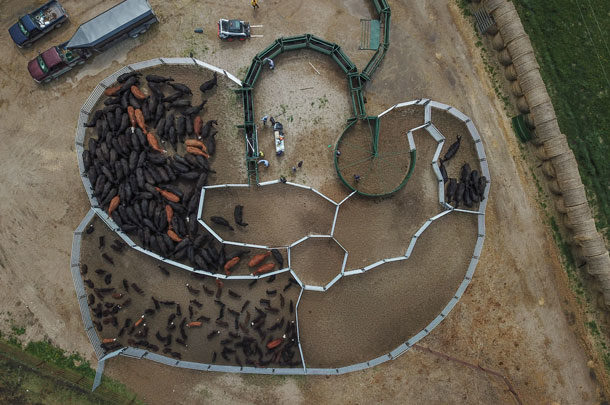Cattle working systems and equipment were introduced to help you take care of your animals in a safer and more manageable setting. Plenty will argue that all you ever need is a head gate and a few panels. Although that might work for smaller operations with just a few head of cattle, it is always recommended to use a properly designed chute, alley and tub to boost productivity and keep your people safe.
Just like any other decision on the ranch, individual preference and ranch logistics will dictate whether you need a stationary or portable system. Consider the layout of your ranch, your main cattle management tasks, sizes and ages of cattle, and number of handlers working as you evaluate different options. Cattle equipment is an investment, so it is also important to think about where you see your ranch in the next five to 10 years.
Advantages of a stationary system:
-
Versatile
If you’re working on upgrading your system, buying a piece at a time or replacing old equipment is much easier to do. Your stationary system can expand together with your operation. -
You can save time
Transport, setup, tear down and re-transport are not necessary. -
Accessible
The equipment will always be at the same place, ready for work. -
Cattle acclimate better
Cattle can become accustomed to the equipment over time with a consistent stationary system design. -
Convenient
A roof, electricity and other amenities can maximize comfort in a stationary system.
A stationary working system has a lot in common with a house. One limitation is that stationary systems are hard to move. The site you select will be the location for quite some time, so choose wisely unless you invest in moving it. There’s also a risk in building your own equipment if you don’t have the proper resources and experience to do so. Settling for a cheaper solution today might be something you will have to pay for in hospital bills instead.
Advantages of a portable system:
-
Easy transport
Nothing is ever permanent, not even stationary equipment – it just takes more time and effort to move it. If portability is the key point of difference, why call it portable if it’s difficult to transport from pasture to pasture? -
Side business opportunity
To earn back your investment quicker, you can rent out the portable unit to cattle handlers in your area. -
Ambulance for your cattle
Portable systems are ideal for emergency situations that happen while animals are out grazing. -
A three-in-one package
Instead of buying several products, a fully portable handling unit comes with a chute, alley and tub built in.
There are people who believe that portables are the better deal among the two, with some ranches even using portable units as stationary systems. Although this might work for smaller operations, larger ones will eventually need a bigger tub and more alleys for efficiency. Since portable units are designed to be practical and rigid for transport, your modifications are limited.
Properly designed portable systems should be easy to transport and should not take more than a few minutes to set up and tear down. Before making a purchase, it is recommended that you try setting up the portable unit yourself to prevent buyer’s remorse.
Innovations in cattle working systems are prevalent and continue to offer advancements to the industry. Look for new technology based on animal science research in your portable or stationary system. Innovations that improve cattle handling systems include:
- Rubber floors: These keep the system quieter and reduce stress for cattle.
- Adjustable alleys: You may be working fewer cattle than anticipated or various age groups. Alleys should adjust to the job at hand.
- A chute for all sizes: Cattle do not come out of a cookie cutter. Sizes vary depending on age, breed and other factors. You want a chute that fits the largest bull down to the smallest calf.
- Electric jacks: This innovation in portable systems eases the transport process.
- Collapsible tubs: Tubs are the trickiest to transport because of thier size and curvature. However, some manufacturers offer collapsible tubs that are easy to fold and unfold, making portable units even easier to transport.
System selection should also incorporate manufacturer considerations. Look at the warranty and customer service quality when evaluating manufacturers of cattle working systems. These extra services can be crucial in helping you reach the maximum functionality of your system, or if a problem arises. Ask questions about the manufacturer and speak with their previous customers to gain better insight.
Portable and stationary cattle working systems have their place on our ranches, and both can make you more effective in your daily operations. Requirements of your ranch will be key in choosing one. Thorough evaluation and consideration of cattle working system options will help you make the best decision for your ranch and effectively work cattle. ![]()
Aleeya Laureola is the content manager and cattle handling research specialist at Arrowquip. Email Aleeya Laureola.
PHOTO: A stationary system is ideal for larger operations that need a bigger tub and more alleys for improved efficiency. Photo courtesy of Arrowquip.








